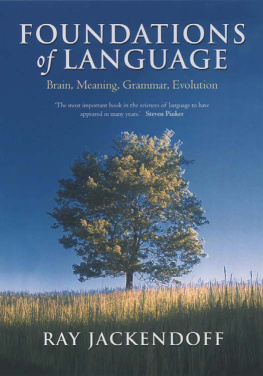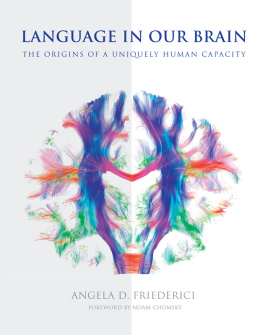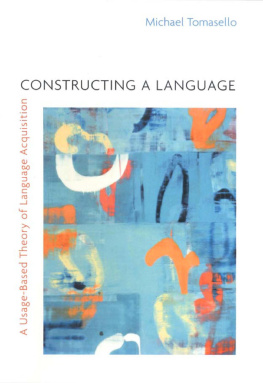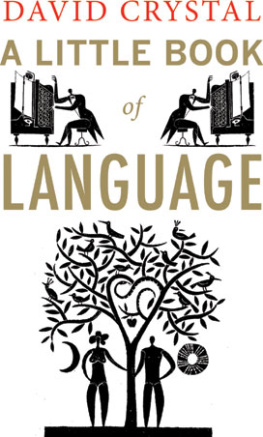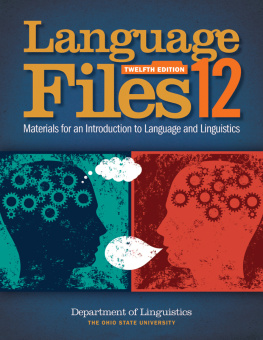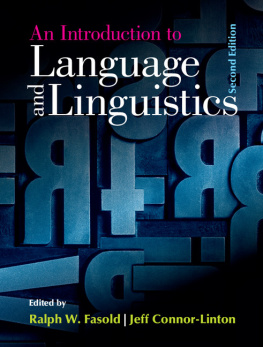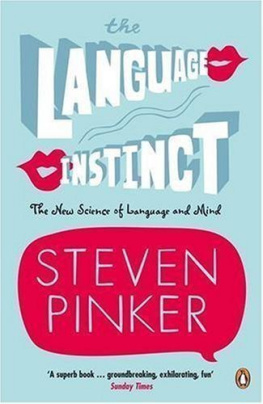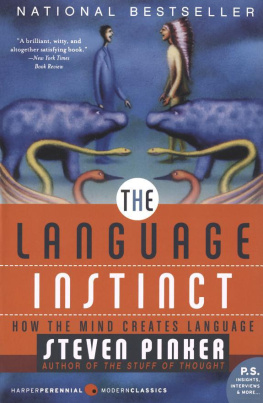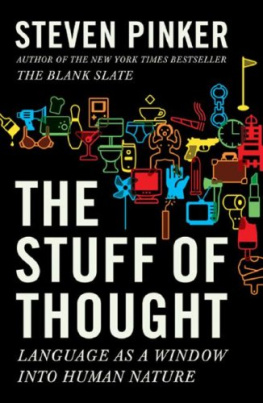
FOUNDATIONS OF LANGUAGE
to our students

FOUNDATIONS OF LANGUAGE
Brain, Meaning, Grammar, Evolution
Ray Jackendoff

Great Clarendon Street, Oxford OX2 6DP
Oxford University Press is a department of the University of Oxford.
It furthers the University's objective of excellence in research, scholarship,
and education by publishing worldwide in
Oxford New York
Auckland Cape Town Dar es SalaamHong Kong Karachi
Kuala Lumpur Madrid Melbourne Mexico City Nairobi
New Delhi Shanghai Taipei Toronto
With offices in
Argentina Austria Brazil Chile Czech Republic France Greece
Guatemala Hungary Italy Japan South Korea Poland Portugal
Singapore Switzerland Thailand Turkey Ukraine Vietnam
Oxford is a registered trade mark of Oxford University Press
in the UK and in certain other countries
Published in the United States
by Oxford University Press Inc., New York
Ray Jackendoff 2002
The moral rights of the author have been asserted
Database right Oxford University Press (maker)
First published 2002
First published in paperback 2003
All rights reserved. No part of this publication may be reproduced,
stored in a retrieval system, or transmitted, in any form or by any means,
without the prior permission in writing of Oxford University Press,
or as expressly permitted by law, or under terms agreed with the appropriate
reprographics rights organization. Enquiries concerning reproduction
outside the scope of the above should be sent to the Rights Department,
Oxford University Press, at the address above.
You must not circulate this book in any other binding or cover
and you must impose this same condition on any acquirer.
British Library Cataloguing in Publication Data
Data available
Library of Congress Cataloging in Publication Data
Data available
ISBN 0198270127
ISBN 0199264376 (pbk)
5 7 9 10 8 6 4
Contents
Preface
xi
Acknowledgments
xvii
PART I PSYCHOLOGICAL AND BIOLOGICAL FOUNDATIONS
1 The Complexity of Linguistic Structure
1.1 A sociological problem
1.2 The structure of a simple sentence
1.3 Phonological structure
1.4 Syntactic structure
1.5 Semantic/conceptual and spatial structure
1.6 Connecting the levels
1.7 Anaphora and unbounded dependencies
2 Language as a Mental Phenomenon
2.1 What do we mean by mental?
2.2 How to interpret linguistic notation mentally
2.3 Knowledge of language
2.4 Competence versus performance
2.5 Language in a social context (all too briefly)
3 Combinatoriality
3.1 The need for an f-mental grammar
3.2 Some types of rule
3.2.1 Formation rules and typed variables 41
3.2.2 Derivational (transformational) rules 45
3.2.3 Constraints 48
3.3 Lexical rules
3.3.1 Lexical formation rules 51
vi
CONTENTS
3.3.2 Lexical redundancy rules 53
3.3.3 Inheritance hierarchies 54
3.4 What are rules of grammar?
3.5 Four challenges for cognitive neuroscience
3.5.1 The massiveness of the binding problem 58
3.5.2 The Problemof 2 61
3.5.3 The problemof variables 64
3.5.4 Binding in working memory vs. long-term memory 65
4 Universal Grammar
4.1 The logic of the argument
4.2 Getting the hypothesis right
4.3 Linguistic universals
4.4 Substantive universals, repertoire of rule types, and architectural universals
4.5 The balance of linguistic and more general capacities
4.6 The poverty of the stimulus; the Paradox of Language Acquisition
4.7 Poverty of the stimulus in word learning
4.8 How Universal Grammar can be related to genetics
4.9 Evidence outside linguistic structure for Universal Grammar/Language Acquisition Device
4.9.1 Species-specificity 94
4.9.2 Characteristic timing of acquisition 95
4.9.3 Dissociations 97
4.9.4 Language creation 99
4.10 Summary of factors involved in the theory of Universal Grammar
PART II ARCHITECTURAL FOUNDATIONS
5 The Parallel Architecture
5.1 Introduction to Part II
5.2 A short history of syntactocentrism107
5.3 Tiers and interfaces in phonology
5.4 Syntax and phonology
CONTENTS
vii
5.5 Semantics as a generative system
5.6 The tripartite theory and some variants
5.7 The lexicon and lexical licensing
5.8 Introduction to argument structure
5.9 How much of syntactic argument structure can be predicted from semantics?
5.9.1 Number of syntactic arguments 139
5.9.2 Category of syntactic arguments 140
5.9.3 Position of syntactic arguments 142
5.9.4 Locality of syntactic arguments, and exceptions 144
5.10 A tier for grammatical functions?
6 Lexical Storage versus Online Construction
6.1 Lexical items versus words
6.2 Lexical items smaller than words
6.2.1 Productive morphology 155
6.2.2 Semiproductive morphology 158
6.2.3 The necessity of a heterogeneous theory 160
6.3 Psycholinguistic considerations
6.4 The status of lexical redundancy rules
6.5 Idioms
6.6 A class of constructional idioms
6.7 Generalizing the notion of construction
6.8 The status of inheritance hierarchies
6.9 Issues of acquisition
6.10 Universal Grammar as a set of attractors
6.11 Appendix: Remarks on HPSG and Construction Grammar
7 Implications for Processing
7.1 The parallel competence architecture forms a basis for a processing architecture
7.2 How the competence model can constrain theories of processing
7.3 Remarks on working memory
7.4 More about lexical access
7.4.1 Lexical access in perception 207
7.4.2 Priming 209
7.4.3 Lexical access in production 211
viii
CONTENTS
7.4.4 Speech errors and tip-of-the-tongue states 215
7.4.5 Syntactic priming 217
7.5 Structure-constrained modularity
7.5.1 Fodor's view and an alternative 218
7.5.2 Interface modules are how integrative modules talk to each other 221
7.5.3 The bi-domain specificity of interface modules 223
7.5.4 Multiple inputs and outputs on the same blackboard 227
7.5.5 Informational encapsulation among levels of structure 228
8 An Evolutionary Perspective on the Architecture
8.1 The dialectic
8.2 Bickerton's proposal and auxiliary assumptions
8.3 The use of symbols
8.4 Open class of symbols
8.5 A generative systemfor single symbols: protophonology
8.6 Concatenation of symbols to build larger utterances
8.7 Using linear position to signal semantic relations
8.8 Phrase structure
8.9 Vocabulary for relational concepts
8.10 Grammatical categories and the basic body plan of syntax
8.11 Morphology and grammatical functions
8.12 Universal Grammar as a toolkit again
PART III SEMANTIC AND CONCEPTUAL FOUNDATIONS
9 Semantics as a Mentalistic Enterprise
9.1 Introduction to part III
9.2 Semantics vis--vis mainstream generative grammar
9.3 Meaning and its interfaces
9.4 Chomsky and Fodor on semantics
9.5 Some contextualist approaches to meaning
9.6 Is there a specifically linguistic semantics?
CONTENTS
ix
9.7 Four non-ways to separate linguistic semantics from conceptualization
Next page
